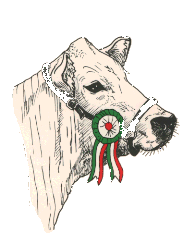

The Podolica breed is a descendent of the bos Primigenius Podolicus, very large-sized long-horned cattle thought to have been domesticated in the Middle East during the fourth century BC. There are two theories about the origin of Podolica cattle. According to one, the Podolica derived from cattle that came to Italy in 452 BC following the Huns who, along their way from Mongolia, passed through the Ukrainian steppe, which can be considered the true birthplace of the Podolica breed. Instead, another theory states that as far back as the first century BC, there existed long-horned cattle from Crete, an area that, even in the Minoan age, had macroceros cattle which can be identified as bos primigenius. The Podolica breed has spread throughout an area that mainly covers the inland territories of southern peninsular Italy (Abruzzo, Basilicata, Calabria, Campania, Molise and Apulia). The breed numbers 100,000 head, 25,000 of which are listed in the Italian Herd Book of ANABIC, the association responsible for the development and selection of this breed. One of the outstanding characteristics of this cattle is its exceptional ability to adapt to particularly difficult environments, as well as its extraordinary capacity to utilize food resources that would not otherwise be used. In fact, this cattle is able to make the most of shrub-covered grazing areas as well as stubble and bush areas, using the leaves of shrubby elements, tree shoots and grassy underbrush.
The Podolica was long used mainly in a work capacity and only secondarily for beef and dairy products. In fact, its milk is ideal for producing the famous "caciocavallo' cheese. Subsequently, with the rise and spread of agricultural mechanization, the selective trend of this breed became geared more towards beef production and, to a lesser extent, towards dairy production, particularly in certain areas. As far as the reproductive aspect is concerned, age at first calving is rather advanced (about 3 years). This is due primarily to the breed's harsh habitat, which can be noted above all during the heat of the summer months, which significantly decreases the amount of food resources available and thus slows down the growth of younger animals. Nevertheless, this type of cattle develops a long reproductive career, breeding for over ten years with an average time span of fifteen months between calvings. For the most part, calvings are spontaneous and are concentrated during the springtime. Calves are suckled for at least four months. The calves are then weaned in order to be sold for slaughter at around 15-16 months, with weights ranging around 300-350 kg. In some cases, as far as males are concerned, heavier bullocks are produced and these subjects are slaughtered at around two years of age, at a weight of 500 kg. The breeding plan for Podolica cattle envisions subdivision of the breeding farms into two groups, according to the type of herd management being used. Group A farms: controlled breeding groups using only one bull,, these are the only breeding farms that can produce males for reproductive purposes. Group B farms, several bulls for each breeding group,, these groups can produce females but must use bulls produced by Group A farms. The focal point of this selection program is given by the Bull-Calves Selection Center, which envisions the entry of calves once a year according to the candidates' morphological and genealogical requisites, as well as the morphological and productive data of the breeding farm itself, with special attention being paid to the dams' maternal and reproductive capacity. The bull calves undergo performance tests in environments similar to the breed's normal habitat, with a minimal supplement of concentrates added to their diet in order to ensure that the rustic and frugal features typical of the breed will be maintained over time. During checks made at the Center, the subjects are weighed periodically and, once testing is completed at around the age of fifteen months, the ones considered to be ideal as far as function and morphology are concerned begin their career as breeders.
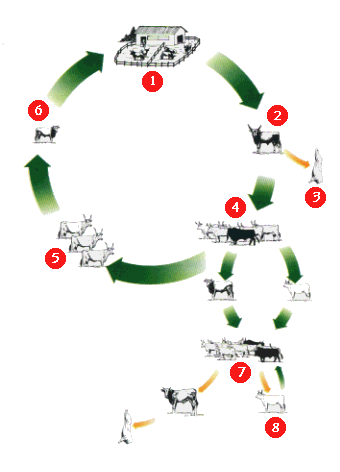 SELECTION GOALS AND SCHEME
SELECTION GOALS AND SCHEME
The selection program makes it possible to obtain maximum progress according to the various farm organizations. All the farms, which are run on a grazing system over a wide area, are divided into two segments A (4) and B (7). Only Group A herds which use just one bull for each breeding group, can supply male breeders. The herds in Group B (with more than one bull for each breeding group), produce females for replacement (8), but must acquire bulls from Group A. The young bulls are assessed and chosen in special centers (1) on the basis of their productive traits as well as the characteristics of their respective dams (5), which are selected for maternal capacity and reproductive efficiency.
Regardless of whether we are talking about hulls or cows, there are three parameters that must be taken into consideration in assessing breeders: productivity, genealogy and morphology. In beef cattle, where morphology also means function, the morphological evaluation becomes particularly important since it allows us to evaluate the capacity to produce muscle tissue and thus meat.In the past, far too, much importance was given to aesthetic details due to the false assumption that there was a correlation between appearance and function. This inevitably led to formal evaluations that neglected the animal's true morphological and functional value and thus went beyond any logic of selection and genetic improvement. Consequently, evaluation methods needed to undergo radical changes. The concept of "outer beauty" was replaced with the concept of 'functional beauty" that was aimed towards identifying animals with the functional and morphological traits to become excellent breeders according to the selective trends that the Association had set for itself. The first significant modification was made in 1986 when ANABIC introduced a new morphological evaluation sheet that attributes greater weight to muscle development traits as compared to other trait groups (skeletal structure and breed characteristics). The definitive turning-point came when the breed standard was revised. With the new standard, in addition to channeling selection towards animals that were closer to market requirements, the following objectives were also pursued:
-maximum emphasis on characteristics related to beef production
- greater tolerance towards "formal" and non-functional morphological characteristics
- elimination of superfluous parts related to general zoognostic concepts
- maximum simplicity of explanation in order to avoid subjective interpretation.
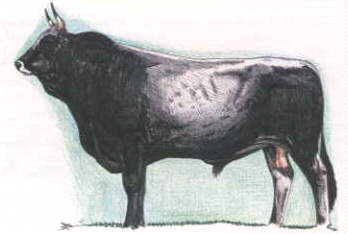
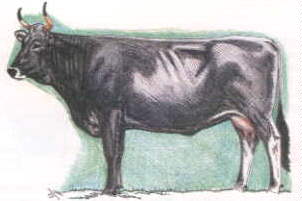
Sexual dimorphism is evident in coat color, which is much darker and tending to go towards black in hulls. The hair is short, fine and shiny. Calves are wheat-colored at birth and turn gray at around three months of age.
The persistence of reddish hair exclusively around the sinciput area, a gray tail and partial depigmentation of the natural apertures, are tolerable in subjects with the functional-morphological requisites needed for listing in herd books.
Skin pigmentation, which is particularly accentuated in this breeds, is ideal for the environments with strong solar radiation such as the areas in which the Podolica is raised.
The skin is oily and is easy to life in thin folds. The skin has a well-developed dewlap, particularly in hulls, which fulfills the need for increased heat dispersion in particularly hot climates.
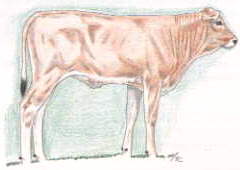
The main reference point as far as the external expression of this breed is concerned, as well as in terms of a valid hormonal balance, the head must be distinctive and expressive, with a broad muzzle and well-developed masseters. Lively eyes. The sinciput has a sharp outline. The horns are slender and are gray in subjects up to the age of two, after which they become yellowish-white at the base and black at the tips. The ears are quite mobile and average in size, with a black edge around the auricle.
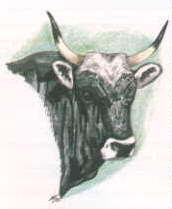
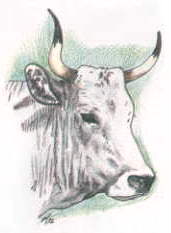
Sexual dimorphism is evident in the neck area. The dewlap must not be overly abundant.
Considering the selective push geared more towards beef production, muscle development in the shoulders must be very evident and the shoulders must be connected harmoniously to adjoining a teas.
This area must essentially be flat, broad and muscular, in keeping with the selective criteria.
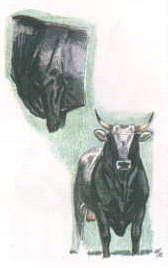
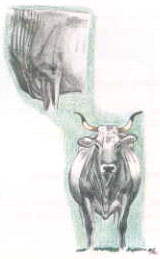
The muscle development in this area must also be evident, especially in bulls.
Due to the commercial importance of this area, the loins must be muscular and thick, above all in males.
The transverse diameters of this area indicate this animal's strength. The chest tends to be narrow in younger animals and widens as the animal gets older.
Given the dynamic past of this breed, this region is well developed and harmonious, and must have adequate capacity.
Good longitudinal development of the trunk generally means that the abdomen will develop its capacity lengthwise in order to contain large amounts of food that is often bulky and coarse.
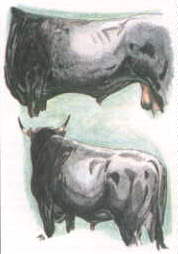
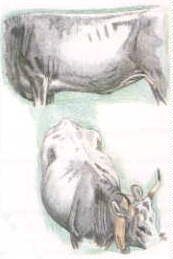
This is one of the most important areas in beef cattle breeds and thus it must be muscular, with a convex line. Its skeletal base, with its marked transverse diameters and proper inclination, must ensure maximum reproductive efficiency, facilitating calving even in primiparae. The sacral vertebrae must not be too evident and the insertion point of the tail must be harmonious, clean and regular.
These areas, which have a primary, role in beef cattle breeds, must be muscular and convex. Muscular development in the hind quarters in particular is one of the traits that needs to be improved in the Podolica breed in order to increase its market value.
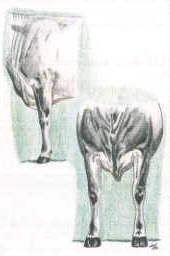
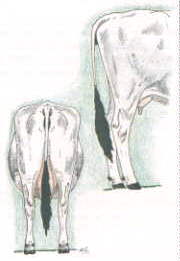
The Podolica has a light skeleton with clean, perpendicular joints and impeccable locomotion. These features are due to the dynamic role performed by this animal for centuries and to harsh environmental selection. This makes it possible for the animal to travel even considerable distances over often rather uneven terrain,while also allowing it to fully exploit available food resources.

The Podolica's foot has an almost perfect conformation, with hooves that are well-closed and sturdy, characterized by excellent heel depth.
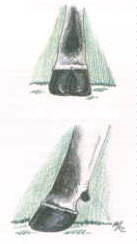
The udder on Podolica cattle is distinguished by its considerable volume and is well-supported by an adequate supporter organ. Development of the quarters and the distribution and shape of
the teats are harmonious. The shape and volume of the teats are particularly important because they must not prevent the newborn calf from suckling. This will ensure that the calf will have the best chance of survival.
The development, volume, shape and symmetry of the testicles are essential for the bull to carry out its reproductive career. No compromise is possible here.
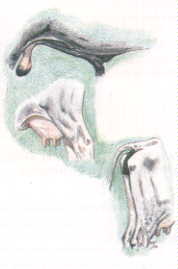
|
Height of withers
|
||
|
Class
|
Cows 1st calving
|
Pluriparae
|
|
1
|
<123 | <124 |
|
2
|
124-130 | 125-132 |
|
3
|
131-137 | 133-140 |
|
4
|
138-144 | 141-148 |
|
5
|
>145 | >149 |
|
Length of Trunk
|
||
|
Class
|
Cows 1st calving
|
Pluriparae
|
|
1
|
<131 | <134 |
|
2
|
132-140 | 135-145 |
|
3
|
141-149 | 146-156 |
|
4
|
150-158 | 157-167 |
|
5
|
>159 | >168 |
|
Height of Thorax
|
||
|
Class
|
Cows 1st calving
|
Pluriparae
|
|
1
|
<58 | <63 |
|
2
|
59-63 | 64-67 |
|
3
|
64-68 | 68-71 |
|
4
|
69-73 | 72-75 |
|
5
|
>74 | >76 |
|
Width of Thorax
|
||
|
Class
|
Cows 1st calving
|
Pluriparae
|
|
1
|
<31 | <31 |
|
2
|
32-35 | 32-36 |
|
3
|
36-39 | 37-41 |
|
4
|
40-43 | 42-46 |
|
5
|
>44 | >47 |
|
Width of Lips
|
||
|
Class
|
Cows 1st calving
|
Pluriparae
|
|
1
|
<42 | <47 |
|
2
|
43-46 | 48-51 |
|
3
|
47-50 | 52-55 |
|
4
|
51-54 | 56-59 |
|
5
|
>55 | >60 |
|
Width of Pins
|
||
|
Class
|
Cows 1st calving
|
Pluriparae
|
|
1
|
<26 | <29 |
|
2
|
27-29 | 30-32 |
|
3
|
30-32 | 33-35 |
|
4
|
33-35 | 36-38 |
|
5
|
>36 | >39 |
|
Length of Rump
|
||
|
Class
|
Cows 1st calving
|
Pluriparae
|
|
1
|
>43 | >45 |
|
2
|
44-47 | 46-49 |
|
3
|
48-51 | 50-53 |
|
4
|
52-55 | 54-57 |
|
5
|
>56 | >58 |